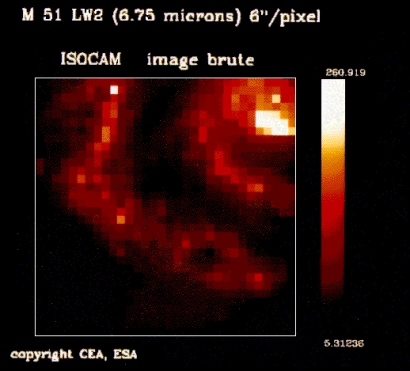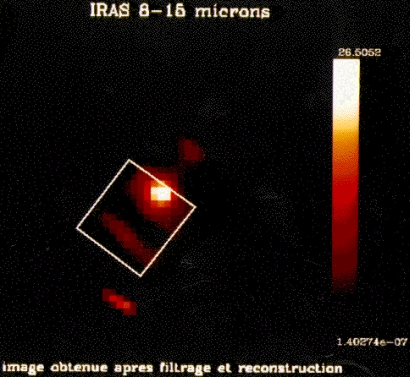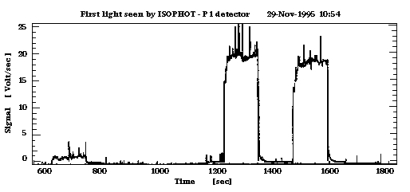PR 64-1995: First light with ISO and its instruments
6 December 1995
ESA's Infrared Space Observatory (ISO) was successfully launched by Ariane during the night of 17 November. The cover closing the cryostat was ejected on 27 November thereby enabling astronomical use of the ISO telescope. All systems on-board the technologically-innovative satellite are working very well, better than specifications and all the ISO instruments have now received first light.On 28 November, the first infrared images were taken with the ISOCAM instrument. The target was the beautiful spiral galaxy, M51, also known as the Whirlpool Galaxy. Images were taken in two infrared colours, at wavelengths of 7 and 15 microns, and at two resolutions, namely 3 and 6 arc seconds. Figure 1 shows the 7 micron ISOCAM image with a spatial resolution of 6 arc seconds.
 |
|
Figure 1: ISOCAM Unprocessed 7 mic ISOCAM image of M51, as seen in real time on 28/Nov/1995. Integration time was 130 sec, scale is 6 arcsec/pix, and total field is 3x3 arcmin. The nucleus is to the upper right, and two segments of spiral arms are clearly visible. Orientation: N is about 28 deg left of down; E is about 28 deg above left. |
Spiral structure in galaxies was first discovered by observations of M51 taken in 1845 by the third Earl of Rosse in Ireland. At a distance of 20 million light years, M51 is not one of our nearest neighbors in space but it is one of the most spectacular, as it presents its spiral structure face-on to us. M51 is smaller and - at a mass of 50 000 million suns - less massive than our galaxy. However, due to intense recent star formation, it is much brighter. While very detailed images have been available for some time in the optical and radio wavelength range, infrared data in the ISO range has been very limited. Figure 2 shows the data from the previous infrared satellite - the American/Dutch/British satellite IRAS; where, in a similar wavelength range, there is not even a hint of the spiral structure.
 |
|
Figure 2: M51 as seen from IRAS in its 8-15 micron band. IRAS's mission was to map the entire sky at 4 wavelengths, and images such as this can be produced from the data. The square shows approximately the area covered by the CAM image in Figure 1. |
For ISOCAM, with its higher spatial resolution and greater sensitivity, not only the spiral structure but also details within are easily visible, even in a raw first light image. Images from ISOCAM data will be compared with maps at other wavelengths to reveal information about the star formation processes in galaxies.
First light for the ISOPHOT instrument was obtained on 29 November 1995 from the star Gamma Draconis. A huge signal was measured in a narrow band filter at 3.29 microns (figure 3).
 |
|
Figure 3: First ISOPHOT light from the star Gamma Draconis. The output of the PHT P1 detector is shown as a function of time: the 3.29 micron filter was selected, and the spacecraft was commanded to scan the PHT entrance aperture over the source. |
The optical axis of the instrument was found by this observation to be as close as 15 arc seconds to the predicted position. The next target was the interacting galaxy, NGC6090, which was clearly detected for the first time at the longest wavelengths, 120 - 240 microns, exclusively available on ISO. This galaxy is about 320 million light years away from us and has already been detected at shorter wavelengths by IRAS. The newly discovered far-infrared emission arises from cold dust (-250 degrees C) in the galaxies warmed up by recently born stars. The rate of star formation is thought to be increased by the close encounter between the two galaxies. Based on previous measurements, about 50 stars per year are estimated to be born in NGC6090. The new measurements have determined the luminosity much more precisely by including a so far invisible region. This will lead to an accurate calculation of the star formation rate and will give an insight into the secrets of "star bursts" seen in many external galaxies. ISOPHOT will be used in larger programmes to study interacting galaxies from the distant passage of objects via close encounters to finally merging galaxies (cosmic "cannibalism").
The Long-Wavelength Spectrometer made its first astronomical observation on 30 November. It measured the infrared spectrum of a region of dust, gas and newly-formed stars known as S106. Lines from Nitrogen, Carbon and Oxygen are clearly visible in the raw unprocessed spectrum. Intense ultraviolet light from the stars heats up the surrounding dust, which re-radiates this energy in the infrared. It also excites atoms in the gas, causing them to emit radiation at precise infrared wavelengths. Unlike visible light, these infrared rays can emerge from deep within the clouds. Measurements like these will allow astronomers to discover the composition, density and temperature of the material and help us to understand the complex processes by which stars and their planetary systems form. The LWS wavelength range, is completely inaccessible from the ground due to atmospheric absorption and, thus, the LWS provides a unique opportunity of studying star-formation. For the Short-Wavelength Spectrometer, first light was obtained on 1 December, during a measurement to determine the focal plane geometry (i.e. the position of the instrument's entrance slit with respect to the telescope) with the star Gamma Draconis as the target. This detection was achieved with an 11 x 11 point raster map and with the spectrometer set at a wavelength of 3.08 microns. The measured flux appears to be within 10% of pre-launch predictions.
Spectral scans of internal wavelength calibrators made during the first check-out show good performance of all scanner mechanisms. For reasons of ISO schedule constraints, SWS - unlike the other instruments - has not yet had the opportunity to make spectral observations of astronomical sources. This will start in the next few days and all indications are that they will be successful.
Following these very successful detections of first light in the instruments, work is continuing on the detailed calibration and performance verification of ISO and its four scientific instruments. It is planned to organise a Press Conference around the end of January 1996 to present initial results.
